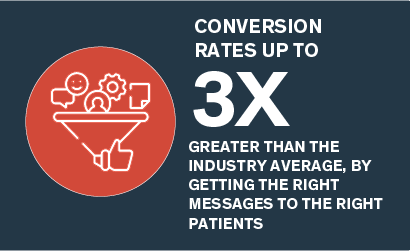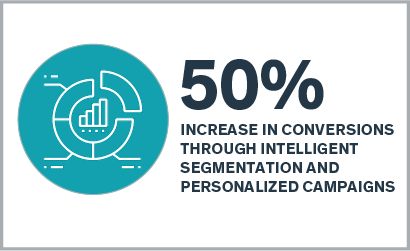Drive healthcare system revenue by turning your data into actionable insights
Whether you’re a healthcare delivery CEO, CFO, service line, or medical group leader, you need to drive revenue. In this blog, we’ll be focusing on top line revenue growth and patient outreach where we explore how you can connect your revenue-generating services with your highest value healthcare consumers.
Can you reach that goal through promotion, broadcasting messages via all the channels and tools your marketing team has in its toolkit? If that’s the approach, how do you know the people who need your services the most are the ones who will see a billboard or digital ad or read the email? And if they do see the message, how easy and likely will it be for them to take action?
Like healthcare delivery itself, effective patient outreach marketing is about aligning the solution to the delivery. Just as you wouldn’t use a general anesthetic when a local works equally well with lower risk, you don’t need a broad marketing campaign when you can target them to your highest value patients most likely to make appointments — and make it easy for them to take action.The key is how you use data.
The Data Dilemma
When it comes to data, most healthcare customer relationship management systems (CRM) are good at storing and aggregating it. You can find out a lot about your patients by looking at what’s in your CRM and your electronic medical records (EMR).
The gap for healthcare is: what do you do with the data? You have a wonderful wide-angle view of each patient…but it can be more overwhelming than enlightening. How do you translate that data to patient activation?
Transforming CRM From a Noun to a Verb

What do we mean by patient activation? Imagine if you could tap into all that patient data and use it to prioritize who needs your services the most. What if, among that group, you could predict who’s most likely to respond? And what if that same system could contact people in a way that generated response rates as high as 45%?
The path to turn data into insights (who needs services most; who’s most likely to respond) and then into action (proactive outreach) is to use CRM as a verb. Data that sits in a system without generating insights or action is using CRM as a noun. The way to translate it to actionable insights is to add artificial intelligence — making CRM into a verb.
“We like to call it CRM intelligence. Healthcare needs intelligence that unlocks the value of existing data — identifying and predicting patient needs to recommend the next best action for every individual. Healthcare as an industry contains a ton of data. The challenge is: how do you act on that data to benefit both your customers and your organization?”
- Alan Tam, VP Marketing, Actium Health
CRM Intelligence = Patient Activation
Many people use CRM to refer to the software itself — as a noun — versus the activity of managing customers — a verb. What does it take, beyond data, to activate patients to book appointments? And if that’s successful, how can you control the volume so that appointments don’t overwhelm capacity?
Just like many retailers, the way to move from a noun to a verb is to add artificial intelligence (AI) and automation to your data. The tools that end up recommending your next book from an online retailer or your next pair of pants from an online store are AI on top of data. That’s often a missing competency in healthcare.
Is Another Tool the Answer for Actionable Patient Outreach Campaigns?
Why not simply run different reports from your CRM and your EMR? Is the answer really more software?
Without AI, you run the risk of using too many resources (to manually build audience lists), missing the best audience (by buying third-party lists), and getting a low response rate (by choosing a channel your audience may not see or finds harder to respond to).
Today, you probably “turn off” your campaigns when your call center, service line, or medical group becomes overwhelmed and bombarded with requests as a result of your campaign. This can result in non-scalable, highly cyclical volumes that deliver poor patient and staff experiences. How can you deliver consistent, predictable appointment bookings that bring in your most valuable patients? Is that even possible?
With AI, you get a solution that uses your data, analyzes it based on tested propensity models, senses your appointment capacity, and reaches out to those who most need a particular service (annual wellness visits, for example) using text messages – which are proven to be more effective than email. The entire campaign can be adjusted up or down, depending on your system’s capacity to see patients in a certain time period.
"Various sources report SMS open and response rates as high as 98% and 45%, respectively — in contrast to corresponding figures of 20% and 6% for email. This is partly due to the number of messages a typical user receives for each type. Users need to wade through far more email noise than SMS."1
The Benefits of AI for Connecting Patients to Care
Some of the key benefits of AI to generate ideal audiences include:


Virtua Health, a comprehensive community healthcare system with five hospitals and 270+ locations, partnered with Actium around cardiovascular disease. Pulling a list with parameters like age would leave out many people at risk: they needed more insights.
With Actium Health’s AI tools, they identified a group of patients and launched a campaign (which included a control group). The results included a 25% impact on appointments and $800,000 in revenue.
“More importantly, we were able to positively impact the lives of patients with elevated health risks.” Ryan Younger, VP of Marketing, Virtua Health.
In fact, using the machine learning of AI with a health system’s data has been shown to be 8 to 12 times more effective at bringing patients in, depending upon the specific procedure required.
Solving the Data Dilemma
You work in healthcare because you want to solve problems and improve people’s quality of life. You can only do that if they choose to interact with healthcare delivery, which means you need proactive patient outreach targeted to those who most need your services.
Or in other words, you need patient activation that takes CRM from a noun to a verb.

Sources:
[1] Tap Into The Marketing Power of SMS, Gartner

